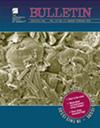On the crumpling and repaving of the North American continent
IF 3.9
1区 地球科学
Q1 GEOSCIENCES, MULTIDISCIPLINARY
引用次数: 0
Abstract
At perhaps the coarsest scale of consideration, the rock cycle operates through fluxes associated with tectonic uplift and erosion, which are generally balanced by subsidence/subduction and the burial of mineral materials that leads to volumetric balance among the principal rock reservoirs. At Earth’s surface, net rates of transfer are manifest as the reduction of areas of older rocks during erosional destruction as well as during burial by younger units. Because exposure of continental crust comprises some finite space, decrease of older rock area by erosion and/or burial must be largely balanced by an increase in area of new sedimentary and volcanic successions. Here, we examine relations between the lateral extents of rock units exposed across North America—their lithology, elevation, and the age of formation—to determine rates of geologic “repaving” that are recorded in the age and area of rocks making up the surface of the continent. Moreover, because deposition occurs at lower elevations, one might expect that subsequent episodes of uplift and/or burial would serve to increase the average elevation of currently exposed sedimentary lithosomes. Because plutonic and metamorphic rocks form at depth and are only exposed along orogenic belts and across shields after extended intervals of uplift and/or erosion, one might expect basement rocks to be initially exposed at higher elevations, and that subsequent erosion would decrease elevation with increasing age. Therefore, processes giving rise to associations between outcrop lithology, extent, and elevation may serve as measures of continent-scale rates of rock cycling. We combine data from the 1 arc-minute global relief model with data from the Geological Society of America’s 2005 Geologic Map of North America to assess the actuality and significance of first-order relations among the lithologies, areas, ages, and elevations of rock bodies now exposed across the North American continent and how these may shed light on deep-time rates of rock cycling. Areas of the 23,642 mapped North American lithosomes make up a lognormal frequency distribution (mode = 121 km2). This distribution reflects both natural (lateral extents of individual map units must be limited in space) and anthropogenic (cartographers must render map units within limited range of sizes) causes. Contiguous, lateral associations of the major rock types suggest that the spatial occurrence of volcanic and sedimentary rock bodies is largely independent of the proximity of other rock types, but exposures of plutonic and metamorphic lithosomes are intimately associated in space and thus comprise the “crystalline basement” exposed in cores of younger orogens and across the Canadian Shield. Unlike sedimentary and volcanic rocks that “attain their age” when formed at Earth’s surface, plutonic and metamorphic units are “born” at depth and therefore must have reached some antiquity prior to first exposure. As a result, the ages of volcanic and sedimentary exposures span the full range of ages represented by all lithologies, while those of plutonic and metamorphic suites are more abbreviated and older. Median ages of North American volcanic, sedimentary, plutonic, and metamorphic exposures are 482 Ma, 306 Ma, 1695 Ma, and 2467 Ma, respectively. Although the areal extent of sedimentary rock decreases with increasing age, elevation increases. This change is interpreted as reflecting progressive tectonic uplift from initial accumulation at lower elevations. In contrast, the surfaces of exposed volcanic, plutonic, and metamorphic lithosomes become lower in elevation with increasing age. This change reflects both the erosional lowering of lithosome surfaces as well as the progressive exhumation of larger areas of crystalline basement. Exposed rock area exhibits a power law decrease with increasing age. This change reflects the progressive destruction of older units and their burial by younger units. A simple “repaving” model in which 0.8% area is uplifted and eroded per million years is in good agreement with observed relations of map age versus area, the rate of which is equivalent to the resurfacing of the North American continent every 63 m.y. or ∼56 times over the past 3.5 Ga. The rate of decrease in map area of exposed rocks with increasing age evident in both geologic map data and repaving models is about three times the rate of decrease in total sediment volume as determined from stratigraphic data and repaving models. The decrease in the areas of exposed rock units is primarily the result of burial by younger units rather than erosive destruction.北美大陆的破碎和重新铺设
在可能最粗略的考虑范围内,岩石循环通过与构造抬升和侵蚀相关的通量运行,这些通量通常通过沉降/俯冲和矿物物质的埋藏来平衡,从而导致主要岩石储层之间的体积平衡。在地球表面,净转移率表现为侵蚀破坏过程中以及年轻单元埋葬过程中较老岩石面积的减少。由于大陆地壳的暴露包括一些有限的空间,侵蚀和/或埋藏导致的旧岩石面积的减少必须在很大程度上与新沉积和火山序列面积的增加相平衡。在这里,我们研究了北美各地暴露的岩石单元的横向范围——它们的岩性、海拔和形成年龄——之间的关系,以确定构成大陆表面的岩石的年龄和面积中记录的地质“再沉积”速率。此外,由于沉积发生在海拔较低的地方,人们可能会认为随后的隆起和/或埋藏会增加目前暴露的沉积岩石圈的平均海拔。由于深成岩和变质岩在深处形成,并且只有在长时间的隆起和/或侵蚀后才沿着造山带和穿过护盾暴露,因此人们可能预计基岩最初暴露在更高的海拔处,随后的侵蚀会随着年龄的增加而降低海拔。因此,在露头岩性、范围和海拔之间产生关联的过程可以作为岩石循环的大陆尺度速率的衡量标准。我们将1弧分钟全球地形模型的数据与美国地质学会2005年北美地质图的数据相结合,以评估目前北美大陆上裸露的岩体的岩性、面积、年龄和海拔之间一阶关系的现状和重要性,以及这些关系如何揭示岩石循环的深层时间速率。23642个绘制的北美岩石圈区域构成对数正态频率分布(模式=121平方公里)。这种分布既反映了自然原因(单个地图单元的横向范围必须在空间上受到限制),也反映了人为原因(制图师必须在有限的尺寸范围内绘制地图单元)。主要岩石类型的连续横向组合表明,火山岩和沉积岩体的空间分布在很大程度上独立于其他岩石类型的接近程度,但深成岩体和变质岩体的暴露在空间上密切相关,因此构成了年轻造山带核心和加拿大地盾中暴露的“结晶基底”。与沉积岩和火山岩在地球表面形成时“达到其年龄”不同,深成岩和变质岩单元是在深处“诞生”的,因此在首次暴露之前必须达到一定的年龄。因此,火山岩和沉积岩暴露的年龄跨越了所有岩性所代表的整个年龄范围,而深成岩和变质岩套的年龄则更为简短和古老。北美火山岩、沉积岩、深成岩和变质岩暴露的中位年龄分别为482 Ma、306 Ma、1695 Ma和2467 Ma。尽管沉积岩的面积范围随着年龄的增加而减小,但海拔增加。这种变化被解释为反映了从低海拔地区的初始堆积开始的渐进构造抬升。相反,暴露的火山岩、深成岩和变质岩的表面随着年龄的增长而海拔降低。这种变化既反映了岩石圈表面的侵蚀性降低,也反映了结晶基底大面积的逐渐剥露。裸露岩石面积随年龄的增长呈幂律递减。这一变化反映了旧部队的逐渐破坏和年轻部队的埋葬。一个简单的“重新铺设”模型,其中每百万年0.8%的面积被抬升和侵蚀,与观测到的地图年龄与面积的关系非常一致,其速率相当于过去3.5 Ga中北美大陆每63 m.y.或~56次重新铺设。在地质图数据和再铺设模型中,随着年龄的增加,裸露岩石的图面积的减少率都很明显,大约是根据地层数据和再铺模型确定的总沉积物体积减少率的三倍。裸露岩石单元面积的减少主要是由于较年轻单元的掩埋,而不是侵蚀性破坏。
本文章由计算机程序翻译,如有差异,请以英文原文为准。
求助全文
约1分钟内获得全文
求助全文
来源期刊

Geological Society of America Bulletin
地学-地球科学综合
CiteScore
9.30
自引率
8.20%
发文量
159
审稿时长
4-8 weeks
期刊介绍:
The GSA Bulletin is the Society''s premier scholarly journal, published continuously since 1890. Its first editor was William John (WJ) McGee, who was responsible for establishing much of its original style and format. Fully refereed, each bimonthly issue includes 16-20 papers focusing on the most definitive, timely, and classic-style research in all earth-science disciplines. The Bulletin welcomes most contributions that are data-rich, mature studies of broad interest (i.e., of interest to more than one sub-discipline of earth science) and of lasting, archival quality. These include (but are not limited to) studies related to tectonics, structural geology, geochemistry, geophysics, hydrogeology, marine geology, paleoclimatology, planetary geology, quaternary geology/geomorphology, sedimentary geology, stratigraphy, and volcanology. The journal is committed to further developing both the scope of its content and its international profile so that it publishes the most current earth science research that will be of wide interest to geoscientists.
 求助内容:
求助内容: 应助结果提醒方式:
应助结果提醒方式:


